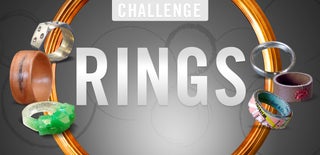Introduction: Wire Wrapped Wrap Ring
This is a traditional wire wrap ring - with a twist. Literally. The beautiful and sturdy band wraps around your finger so you don't need to worry about ring sizing, making it perfect for gift giving.
Step 1: What You'll Need
Wire:
You can use any kind of nontoxic metal wire, though I prefer to by jewelry grade wire online. Wire Sculpture and Rio Grande are excellent sources. If you're just beginning I recommend copper or bronze. They're inexpensive and look great with polish or patina. To get started buy at least 5 feet of 22 gauge, dead soft, SQUARE wire and 2 feet of 21 or 22 gauge, dead soft, HALF ROUND wire.
Tools:
Tools are very important. I used cheap jewelry pliers (~$10) for a while, but once I was sure I would stay with wire wrapping, I got good ones (~$50). It made a huge difference, especially in how tired my hands would get. If you do this, hang on to your cheap tools - there's always a use pliers you won't worry about. The basic tools you will need to get started are:
Flat nose pliers
Round nose pliers
Wire cutters
Marker
Ring mandrel
Ruler
Optional:
Beads or crystals that fit on the wire. 4mm and up is usually good.
Step 2: Cutting the Wire
Measure
Remember that this ring is adjustable, so don't worry too much if your measurements seem a little off at any point. That being said, here are the measurement instructions:
Take a piece of string and wrap it around your finger or ring mandrel (if you know your size). Go once around and then another time half way around with each side of the string. Then add 3 additional inches. Using a ruler, measure what you just marked off on your string. This will be the length of one strand wire. You'll cut all square wire strands against this length.
My length turned out to be 8 inches. It is better to err on the side of cutting too long then not having enough wire when you wrap. This will be the length of the 22 gauge, square, dead soft wire. Cut six strands of this length. I cut 4 of silver and 2 of copper to make it easier to see the difference in the strands and what is happening with the project. You can design any pattern you like from any wire.
Now cut five half round pieces of wire. Make them one and a half inches each.
If you want to twist any of the wire, now is the time. This makes a nice decorative element to your design. I twisted the two center copper wires.
Step 3: Making a Bundle
The six wires are wrapped together with the half round wire into a bundle. The bundle is the base for the ring band. The object is to make a flat strip held together at five points. The short pieces of 1/2 round wire will hold the square wires together.
To Start:
Pick up one piece of 1/2 round wire and use the flat nose pliers to bend 3-4 mm of the top over. Then angle the bend slightly. Make sure the flat side of the wire is on the inside surface. This will fit neatly around the square wire. Repeat with all the short half round pieces.
Step 4: Continue...
Next hold the square wires together side-by-side. You may need to wiggle them around a little to get them to line up. Then hook the bend of the 1/2 round wire over one edge as shown.
Give a gentle squeeze with the flat nose pliers to secure. (When wrapping, the front of the wraps should be 90 degrees to the bundle wires. The back of the wraps are usually angled.) Now hold the square wire bundle with the flat nose pliers very close to where you will wrap the short pieces around. Start winding the 1/2 round wire around the bundle, but stop every time you make a turn and give the wires a gentle squeeze with the flat nose pliers. Expect to be moving the bundle and the pliers around a lot, changing hands when you need to.
Wrap the 1/2 round wire around the bundle this way 3-4 times and end on the back of the bundle. Cut the excess 1/2 round wire so that it overlaps the back 3 – 4mm.
Step 5: Ring Bundle
Starting with the middle wrap and working outward, make five total wraps (fairly evenly spaced), over about 3 inches.
Step 6: Shape the Band
When you have a nice bundle with five wraps you can start shaping the ring.
Hold the bundle on the ring mandrel with your thumb over the central wrap. Then gently start bending the sides over the ring mandrel. Come around the back and up to the other side.
Step 7: Keep Shaping
There should be a single band in the back of the ring and overlapping bands in front.
Step 8: Fan Out the Wires
I like to gently fan out the wires to see exactly what I have to work with.
Step 9: Get Artistic
Now it's time to add embellishments and finish the ends. You can use the following suggestions or use your own favorite wire techniques.
Making filigree
Here’s where the real artistry comes in. The filigree is the delicate looking swirls and swoops that make up the design of the wire wrap. You make it with the loose ends of wire after the band is the right size and shape. Exactly what you do is up to you, but remember to add your beads while the wire is still fairly straight.
Step 10: Decorative Techniques
Rosettes
This is probably the most common design element in wire wrapping. You make a rosette by using your round nose pliers to make a tiny round loop at the end of a wire. Then wind the loop into a tight spiral using flat nosed pliers. To do this hold the wire in one hand and rotate the wires in the other hand a quarter turn at a time. You can make the rosettes with twisted or untwisted wire for different looks.
Loops
Making loops and shapes with the wire is a lot of fun, but don’t go too big or the wire will bend too easily. Keep swooping wires tight to the setting and find a way to secure the end on another wire.
Twist
Use flat nosed pliers to hold a loose wire end and twist.
NOTE
If you're not sure what to do, add a few crystals (1 each) to several wires and cut all the wire ends to about a 1/2 inch. Then make rosettes out of all the ends.
Step 11: Finish Your Ring
When you're done with decorative elements, trim off any extra wire (you can save it for other projects) and tuck any loose ends under. Feel the ring with your fingers for rough spots and then rub the front and back on a piece of fabric. If you find any sharp spots or wires that catch; file, trim or tuck in the problem wires until everything is perfectly smooth. If at any point your ring gets misshapen, just put it back on the ring mandrel and press it back into shape. If it's hard to shape with you fingers, use a nylon or rawhide hammer.
Now you can add a patina, buff and/or seal your ring if you want.
Have fun!

Participated in the
Rings Challenge

Participated in the
Guerilla Design Contest

Participated in the
On a Budget Contest













